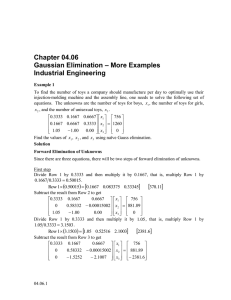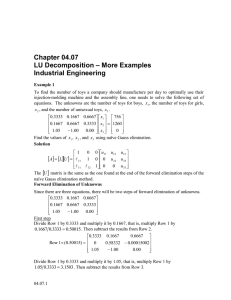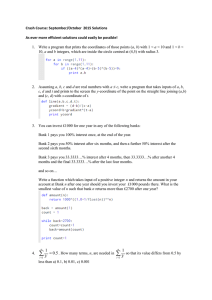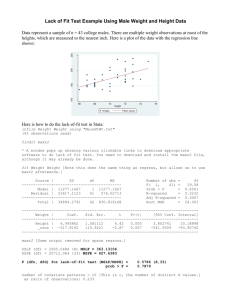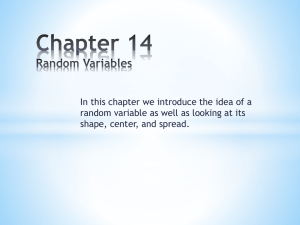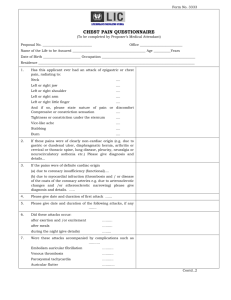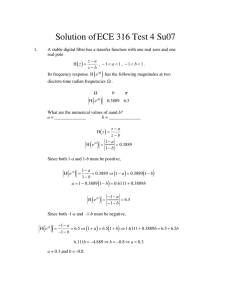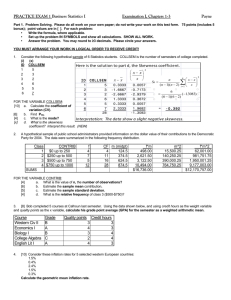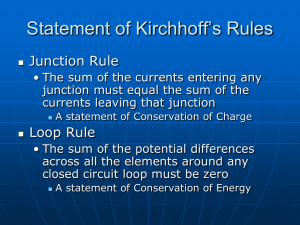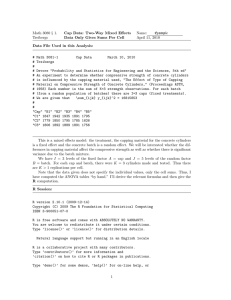Document 11103740
advertisement
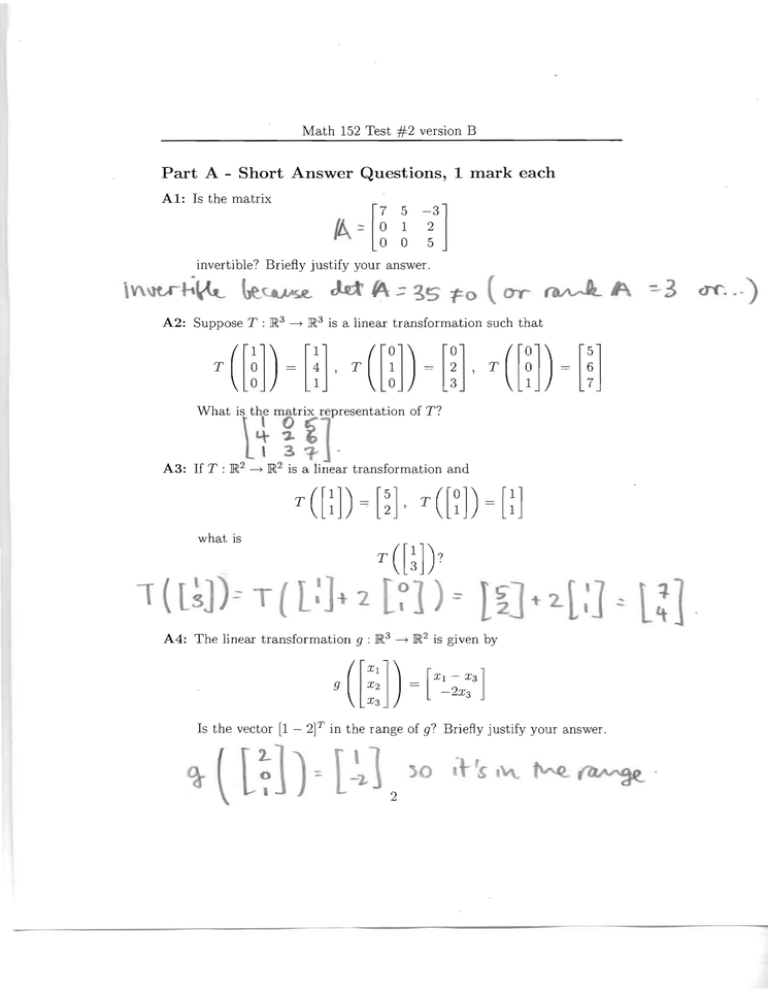
Math 152 Test #2 version B
Part A - Short Answer Questions, 1 mark each AI: Is the matrix fA. ~ [~ ~
o
0
-;3]
5
invertible? Briefly justify your answer. \v\\lt,rh~ ~~SR, J.dA=~5"fO
(fYr
~A ~3
A2: Suppose T : IR3 -; IR3 is a linear transformation such that
T
What
WD ~ m, WD m, WD ~ m
=
T
T
i\
thl mo t' t 'lepresentation of T?
L1i1' ­
A3: If T : IR2 -; IR2 is a linear transformation and
T([n)
=
[~],
T([n)
=
[n
what is
A4: The linear transformation 9 : IR3 -; IR2 is given by
Is the vector [1 - 2]T in the range of g7 Briefly justify your answer.
err._-) Math 152 Test #2 version B
A5: A is a 3 x 3 matrix typed into MATLAB. It has determinant 4. What
is the output of the MATLAB command rref (A)?
, () 01
()
'0
() Q'
A6: Three of the following statements about an n x n matrix A are equiv­
alent. Circle the statement below that is not equivalent to the other
three.
(a) A is invertible.
(b) det(A)
@
# O. The rows of A are linearly dependent. (d) The rank of A is n.
A 7: Consider a random walk with 2 states. The probability of staying at
either state is 1/2. If the walker is in state 1 initially, what is the
probability that he will be in state 2 after 3 time steps?
2
.,~
y~
-"'
p
o~
V1
:s.]
~2-
~"a
~
~
Ill... .
3
:1.
x. :- ['/~] .' .
Math 152 Test #2 version B
Figure 1: Circuit for problems A8, A9 and A10.
A8: For the circuit in Figure 1, write the linear equation th at corresponds
to Kirchhoff 's voltage law applied to loop 2 (that is, the loop that
corresponds to the loop current i2 in the figure). Write your equation
in terms of the loop currents itnd voltage drops in the figure.
A9: For the circuit in Figure 1, write the linear equation that corresponds
to the match of loop currents to the current source I.
~-
2.-I
A1D: For the circuit in Figure 1, write the current J through the voltage
source in terms of the loop currents.
4
(
Math 152 Test #2 version B
Part B - Long Answer Questions, 5 marks each
Bl: Compute the inverse of
A
I
~
-,
3
't
\
i
I
,
a..
0
i)
,
C>
0
I
0
il
1.
0
I
0
0
- I
-,
I
u
1
0
2
-,
o
o
-Il
1-
'l I
o
-'t
0
I
0
o
,
-
....
0
,
0
0
,
rl. ~ ('3.
I
I
.- I
- I, -'1­
I
0
0
-4- 0
-t I
D
o
0
~ [~
0
-1
1
r-1.
+
('-3 ­
- I
2- 2.
o ,
-\
-1
5
).
t-l"'2.'O..
f"'3-'trt
Math 152 Test #2 version B
B2: A tourist visits a tropical island. She spends each day in one of the four
cities on the island . If she is iIi the first city one day, she will move to
the second or third with equal probability but will not stay in the first
city or go to the fourth. If she is in the second city, she is equally likely
to be in any city the next day. If she is in the third city, she will move
to the first or fourth city with equal probability but. will not stay in
the third city or go to the second. If she is in the fourth city she stays
there half of the time or goes to the second city the other half of the
time. Her movement between the cities is considered as a random walk
with transition probability matrix P. Some MATLAB computations
with P determine that
e
0.1680
0.3320
0.1484 0.1680
[
.
6 0.3320
0.2109
4
P
~
0.1250
0.3750
0.1875
0.3125
0.1641]
0.3359
0.1641 and J~~ pn
0.3359
,-.....,..­
,
0.1667
0.3333
0.1667
0.3333
~
0.1667
0.3333
0.1667
0.3333
0.1667]
0.3333
0.1667
0.3333
(a) [2 marks] Write the matrix P.
(b) [1] If the tourist starts in the first city, what is the chance she will
be in the third city after 4 days?
(c) [1] If the t.ourist starts in the first city, what is the chance she will
be in the third city after a long time on the island?
(d) [1] Explain briefly why the answer to the last question docs not
depend on the location where the tourist began her stay.
(f>
Q)
b)
~)
::::
~'t
-­
0
Y'1-
'h
'f.a.
'/~
0
0
Y2.
Y?
Y4-
0
0
a
Ytt-
'I"J.
'/~
Ip't
)0
,
M
)
,
'::
P'
~l!
[~1 ~ o. Itt t
~
"'-oS
ptul-)'
s~~ . ~
a(
,
~Mt'\. .06
lJq
tLi-o
O.l'ti
~td
CA~.
~ · (P
p\)Q
~
artl
-
)
,
rO\A.r
,
Math 152 Test #2 version B
B3: Consider the 2D projection P, rotation R and reflection F given in
terms of their matrix representations below:
Ndte.: F- is Nt
1/5
2/5]
P = [ 2/5 4/5 '
R=
[4/5
-3/5
3/5]
4/5 '
F = [-3/5
4/5
4/5] -3/5
-­
14~X~
~dvtJ
(a) [1] Evaluate
h,
lWs £tAd.
(b) [1] Find all vectors x such that P( x) = o.
(c) [1] What is the matrix representation of T(x)
composition of R and F)?
=
R(F(x)) · (the
-
7
,~
,~,
t
~t~.
[ ].
::
f\.o
~ktA-.M
(d) [2] What is the equation of the line onto which P projects? Write the line in the form y = ax with a determined. -
ex. ~po.
